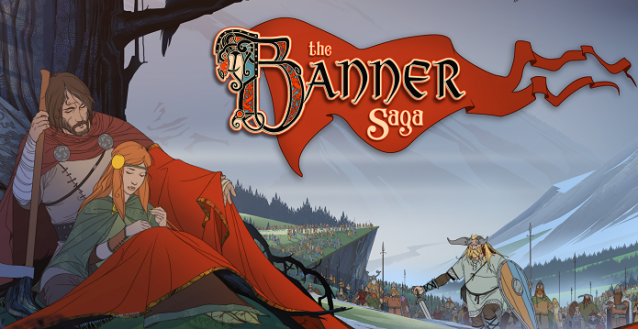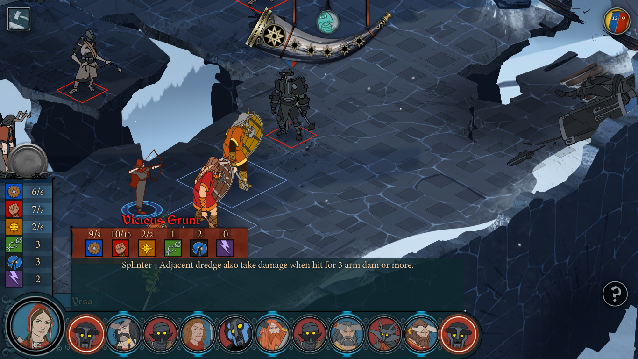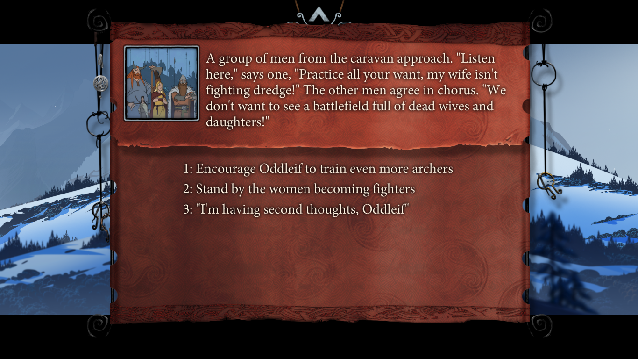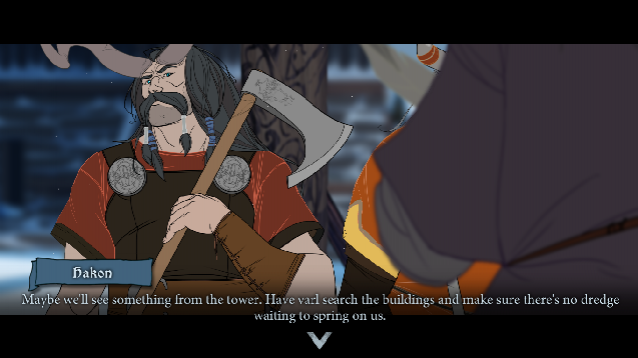


The first thing you'll notice when The Banner Saga begins is how gorgeous it is. A group of giant, horned men trek across a flowing, snowy landscape towards a seaside town. Soft music plays in the background, foreshadowing the melancholic journey ahead. Developer Stoic coined the game as a “mature, story-driven, turn-based strategy game steeped in viking culture,” but it wasn't the story, or the turn-based strategy that hooked me. Rather, the game's smooth animation, soft soundtrack, and gorgeous hand-drawn artwork grabbed me immediately, and kept me playing long enough to become invested in all other aspects of the game.
The Banner Saga stars three races: men, varl, and dredge. The varl are giant, horned men with impressive beards, and the dredge are mysterious, armor-clad creatures responsible for the game's initial conflict. The gods are long gone, the sun has stopped moving, and the dredge have seeped out of the north to slay men and varl alike. With these dire circumstances as a backdrop, The Banner Saga begins with two alternating story lines. The first narrative follows a group of varl—escorting the prince of men, no less—as they are waylaid by the dredge. A man named Rook headlines the second narrative as he takes responsibility for his fleeing community after the dredge destroy his village.

Jumping between two stories makes The Banner Saga seem unfocused at first; however, a half dozen hours in, both tales gain enough traction to remain compelling despite frequently interrupting one another. Strong themes of displacement and growing responsibility feature prominently in both, which kept me interested in the game's overarching narrative. While many of the two dozen characters that star in The Banner Saga are forgettable, tough-guy viking types, a few excellent characters helped keep me engaged. Oddlief, a widowed woman who takes it upon herself to train young women how to fight, was one such character.
The Banner Saga also divides its time between two different gameplay mechanics. You spend half your time managing the fate of the men, women, children, and varl in your caravan. Often, text-based events interrupt your caravan's progress. A group of men might ask to join you, or you might stumble upon pilgrims beset by bandits. What you decide to do in these circumstances can have severe consequences, or they might initiate a battle. If you're really unlucky, a beloved character might die as a result. The Banner Saga does a wonderful job of keeping these events intense and unpredictable. More than once I held my breath as I clicked though the text boxes and made my decisions.

The other half of your time is spent in turn-based, isometric battles. These battles play out on a grid with six of your heroes up against a handful of enemies. Each unit has two resources to manage—armor and strength. Strength doubles as health in The Banner Saga, so a unit's ability to inflict damage lowers along with his or her health. Of course, armor deters the damage done to strength. Strategy boils down to attacking either stat at the right time; for example, I would often utilize my archers to weaken my enemies' armor before moving my heavy hitting varl in to attack their strength.
Caravan management plays directly into these battles. If the caravan's morale is high, more willpower is made available to your heroes in battle, which allows them move farther and preform stronger attacks. Furthermore, the strength of your caravan outside of battle can be utilized to lessen the amount of enemies your heroes face. Despite this extra layer of strategy, The Banner Saga's combat still feels too simple. While the game features seven classes and two dozen characters with unique abilities, battles are frequent, and often you'll be thrown into fights against similar enemies one after another. It's sometimes a grind. Furthermore, if a battle goes awry there's no quick restart button. Having to reload your last save, click through a bunch of dialog, and begin the battle over again becomes a frustrating cycle.

That said, Stoic had me hooked within the first five minutes through the visual and sound design alone. The hand-drawn art style is reminiscent of animated feature films, and in conjunction with a soundtrack composed by Austin Wintory (of Journey fame), The Banner Saga presents a melancholic, unforgettable atmosphere which will grip you immediately. It's a shame more couldn't have been done to give the battles more complexity, but the choices you're forced to make throughout the adventure, and the sheer beauty of the world, more than make up for a lack of strategic depth. In fact, I could've played The Banner Saga on aesthetic direction and risk management alone—both are that engaging.
8 out of 10
A copy of the game was provided by the publisher for the purpose of this review.




 OBS Guide: How to Stream to Twitch
OBS Guide: How to Stream to Twitch On Objectivity in Game Criticism
On Objectivity in Game Criticism Sieger Walkthough
Sieger Walkthough Black Screens Do More Harm Than Good on LCD Monitors
Black Screens Do More Harm Than Good on LCD Monitors Rock In Rio (USA) 2015 lineup includes Sam Smith, Magic!, Jessie J, Gary Clark Jr. and Ivete Sangalo
Rock In Rio (USA) 2015 lineup includes Sam Smith, Magic!, Jessie J, Gary Clark Jr. and Ivete Sangalo